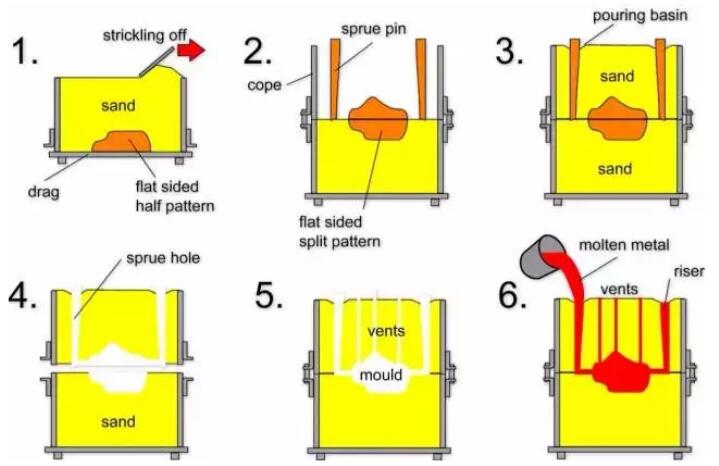Comparison of casting and machining

Table of content:
1) Introduction: how to choose between casting and cnc machining?
2) What is casting?
3) What is machining?
4) Advantages of casting and machining
5) Disadvantages of casting and machining
6) Conclusion
How to choose between casting and cnc machining?
In the manufacturing, die casting and CNC machining are two widely utilized processes that cater to different production needs. Die casting involves injecting molten metal into a mold to create parts with complex shapes, while CNC machining utilizes computer-controlled tools to remove material from a solid block, resulting in precise components. Both methods have unique advantages and limitations, making them suitable for various applications.
When designing a machined part, selecting the right material is paramount. Aluminum alloys are commonly chosen across various industries, including automotive, medical, aerospace, and machinery, due to their lightweight characteristics and excellent conductivity. This raises an important question: should the part be produced using casting or CNC machining? This article will explore the comparison between these two manufacturing processes, highlighting their pros and cons.
What is casting?

First, what is casting?
Casting is a manufacturing process in which a liquid material, typically metal, is poured into a mold and allowed to solidify into a desired shape. This method is widely used to create complex geometries and large components that may be difficult or costly to produce using other methods.
There are several types of casting processes, each suited for different applications and materials. Here are some of the most common types:
1. Sand Casting
Sand casting is a versatile and widely used casting process in which molten metal is poured into a mold made from sand. This method is known for its ability to create complex shapes and is commonly used in various industries for producing both small and large components.
2. Die Casting
Die casting is a metal casting process that involves forcing molten metal into a mold cavity under high pressure. This method is primarily used for non-ferrous metals, such as aluminum, zinc, and magnesium. Die casting is known for producing parts with excellent dimensional accuracy and smooth surface finishes.
3. Investment Casting (Lost Wax Casting)
Investment casting, also known as lost-wax casting, is a precise and versatile manufacturing process used to create complex metal parts. It involves creating a wax pattern of the desired part, coating it with a ceramic shell, and then removing the wax to leave a mold for pouring molten metal. Suitable for high-precision parts and complex geometries, often used in jewellery and aerospace.
What is Machining?
Machining is a manufacturing process that involves removing material from a solid workpiece to shape it into a desired form or finish. This subtractive manufacturing technique is commonly used to create precise components in various industries.
Machining is widely used in various industries, including:
- Automotive: Engine components, transmission parts, and chassis.
- Aerospace: Structural components, brackets, and fittings.
- Medical Devices: Surgical instruments and implants.
- Manufacturing: Machinery parts, tools, and equipment
The advantages of casting & machining.
| Criteria | Casting | Machining |
|---|---|---|
| Precision and Accuracy | Moderate to high precision (varies by method) | High precision and tight tolerances |
| Complex Geometries | Excellent for complex shapes | Good for intricate designs |
| Material Versatility | Primarily metals (ferrous and non-ferrous) | Wide range of materials (metals, plastics, etc.) |
| Production Speed | High production rates for large volumes | Slower for high volumes; faster for low volumes |
| Surface Finish | Good surface finish (varies by method) | Excellent surface finish, minimal post-processing |
| Cost-Effectiveness | Economical for large-scale production | Cost-effective for small to medium production |
| Initial Setup Costs | High mold costs (for some methods) | Lower initial setup costs |
| Material Waste | Low waste (especially in processes like die casting) | Can generate waste, but advancements reduce it |
| Flexibility in Design | Less flexible once molds are made | Highly flexible; easy to modify designs |
| Large Part Sizes | Suitable for large components | Limited by machine size, but can handle various sizes |
In summary, casting is ideal for producting complex shapes in large volmes at a lower cost per part, particularly when the intiial investment in molds is justified. It is well-suited for large components and offers good surface finishes with minimal waste. However the tolerance might not as precise as machining. While, machining on the other hand, excels in precision and flexibility, making it the preffered choice for parts that require tight tolerance and intricate details. It is more adaptabe to design changes and works with a broader range of materials.
Disadvantages of Casting & CNC machining
Both casting and machining have their drawbacks. Here’s a comparative overview of their disadvantages:
|
Casting tends to have disadvantages related to precision, flexibility, and initial costs associated with mold creation. While it is efficient for high-volume production, it may not be ideal for intricate designs that require frequent changes. Machining, while capable of high precision and flexibility, can result in greater material waste and slower production rates for high volumes. It may also require skilled labor for certain operations.
Conclusion
In conclusion , the comparison table provides a clear overview of the advantages and disadvantages of both casting and machining, helping designers make informed decisions based on their specific project requirements. By considering factors such as production volume, material type, part complexity, and cost, designers can determine which process will best meet their needs.
Sep 30,2024
